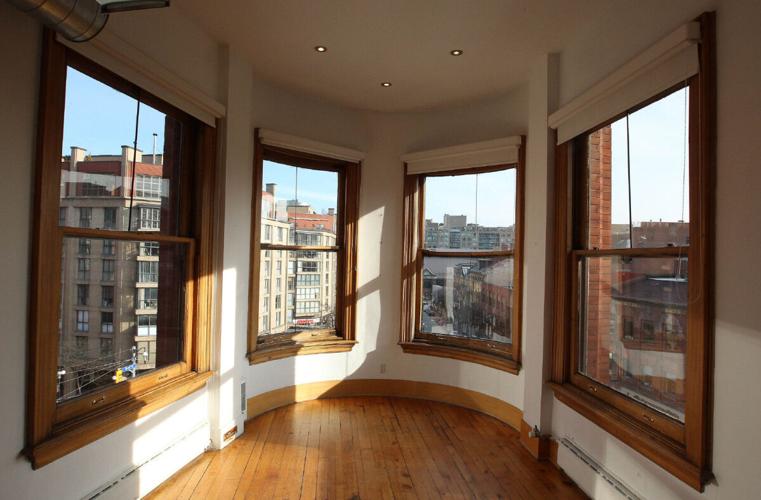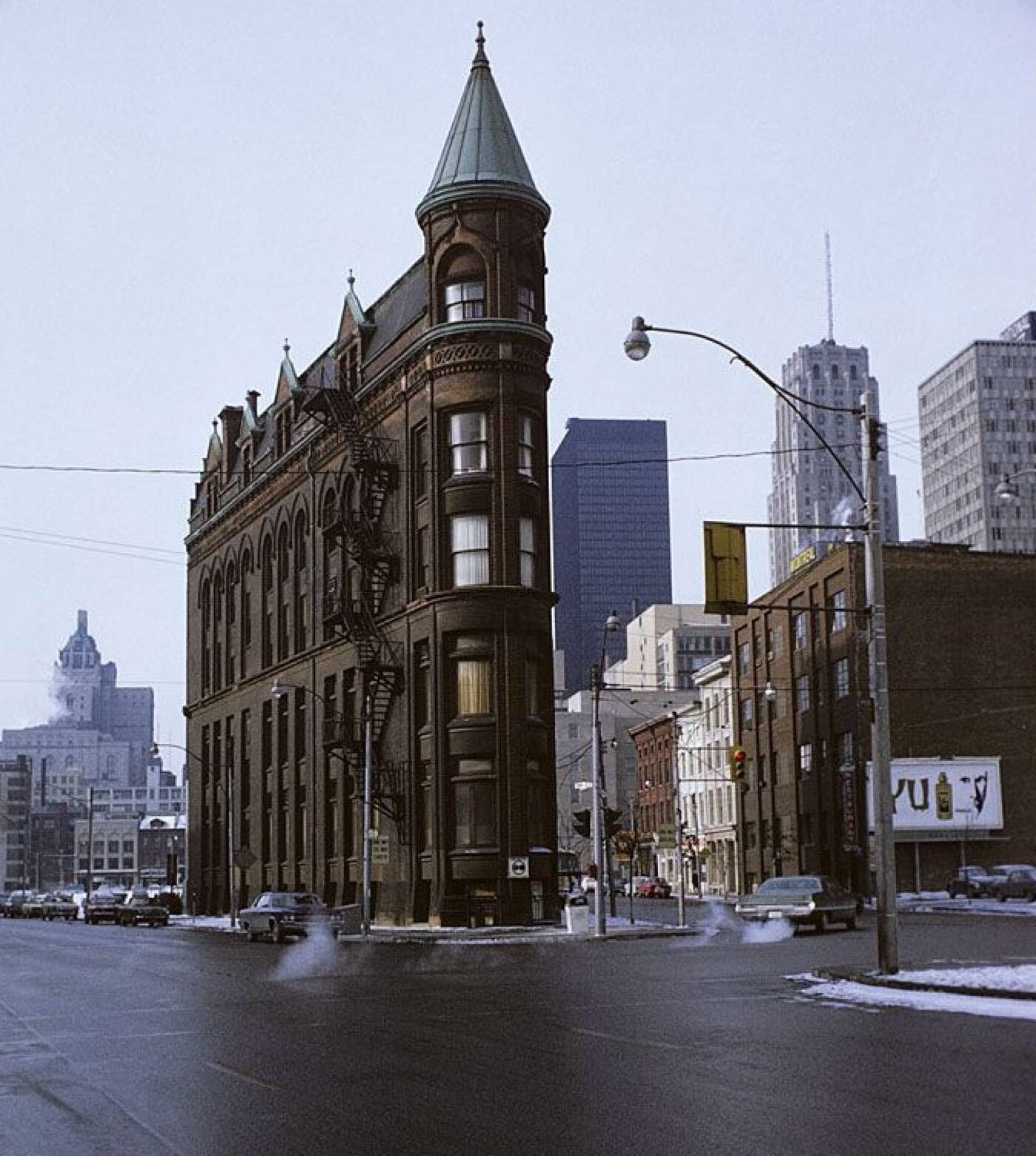Check Out the Historic Value of the Gooderham Building Found in Toronto
The Gooderham Structure, finished in 1892, symbolizes an abundant tapestry of Toronto's architectural and industrial history, created by the notable David Roberts Jr. Its striking triangular form and intricate Romanesque Revival details not only symbolize a lost period yet additionally highlight the structure's advancement from a distillery warehouse to a bustling commercial room. As it stands today, the Gooderham Building continues to play a crucial function in the city's cultural landscape, motivating a more detailed examination of its ongoing impact on both the local economy and area identification. What much deeper stories does this site hold?
Architectural Layout and Design
Although the Gooderham Structure, usually described as the Flatiron Building due to its distinct shape, showcases a fascinating mix of architectural styles, it is mostly defined by its Romanesque Revival layout. This architectural selection mirrors the influence of 19th-century trends, stressing robust kinds and complex detailing. The structure's three-dimensional facade features rounded arcs, heavy stonework, and decorative block patterns, which together develop a feeling of monumentality and durability.
The framework's unique triangular profile, which arises from its place at the junction of Front and Wellington Streets, even more boosts its architectural significance. The sharp angles and plunging rooflines contribute to a vibrant silhouette that stands out against Toronto's sky line. Furthermore, making use of terra cotta and red block materials includes warmth and texture to the building, welcoming closer examination and recognition of its workmanship.
Additionally, the Gooderham Structure's ornamentation, consisting of cornices and gargoyle-like figures, exhibits the artistic embellishments common of the Romanesque design. This attention to information not only improves aesthetic allure however additionally serves to communicate the structure's historical and cultural value, strengthening its status as a treasured architectural site in Toronto.

Historic Background and Construction
The Gooderham Building's architectural value is deeply rooted in its historic context and building. Completed in 1892, this legendary structure was initially created as a distillery storage facility for the Gooderham and Worts Distillery, one of the biggest distilleries worldwide at the time. The building was developed throughout a period of quick industrial development in Toronto, showing the city's growing economic landscape.
Created utilizing local block and featuring a distinct flatiron shape, the Gooderham Building stands at the junction of Front and Wellington Streets, exemplifying the cutting-edge spirit of late 19th-century style. The design, credited to designer David Roberts Jr., incorporates aspects of Romanesque and Gothic styles, showcasing detailed outlining and a prominent turret that additionally enhances its silhouette.
The structure's building was noted by the use of innovative design techniques for the period, allowing it to climb to 6 tales while accommodating the practical demands of the distillery. Over time, the Gooderham Structure transitioned from industrial use to business and retail rooms, yet it remains an important part of Toronto's architectural heritage, signifying the city's historic evolution and durability.

Economic Effect On the Location
Given that its conclusion, the Gooderham Building has actually dramatically affected the regional economic climate, acting as a driver for growth and growth in the surrounding area (Gooderham Building address). Its legendary design and tactical location in the heart of Toronto have actually drawn in numerous businesses and specialists, promoting an environment ripe for entrepreneurship and financial investment
The building's unique layout and historical value have actually made it a centerpiece for tourist, attracting visitors from around the globe. This influx of tourists has actually stimulated regional companies, consisting of restaurants, stores, and social venues, therefore enhancing the overall financial vigor of the district. The existence of the Gooderham Structure has led to raised residential or commercial property worths in the area, contributing to metropolitan revenue with residential property tax obligations.

Cultural Significance and Occasions
Past its economic payments, the Gooderham Building holds significant cultural value in Toronto's landscape. As a notable architectural treasure, it personifies the Victorian Romanesque design, reflecting the city's historical development. The structure's legendary flatiron form adds to its status as a cherished sign of Toronto, bring in both citizens and tourists alike.
The Gooderham Building serves as a dynamic backdrop for different social occasions and artistic activities (Gooderham Building address). It frequently holds art exhibits and neighborhood events, promoting a sense of connection among locals. Furthermore, its existence improves the personality of the St. Lawrence Market area, understood for its rich history and vibrant community life
Film and digital photography enthusiasts frequently look for the Gooderham Building for its picturesque appearances, making it a preferred topic in numerous media. Led strolling scenic tours regularly highlight the building's fascinating stories, linking it to Toronto's wider historical narrative.
Additionally, the Gooderham Structure plays a crucial duty in commemorating neighborhood society, with close-by events such as the Toronto International Film Festival and the Doors Open Toronto campaign frequently featuring it as a vital site of interest (Gooderham Building address). Its long-lasting tradition highlights the significance of preserving social sites within a developing urban environment
Preservation and Reconstruction Initiatives
Amidst Toronto's dynamic metropolitan landscape, preservation and reconstruction efforts for the Gooderham Structure have come to be crucial in preserving its building stability and historic importance. Created in 1892, this famous framework shows the distinct Flatiron style, identified by its special triangular shape and classy brickwork. Continuous campaigns aim to guard its original attributes while adapting to modern-day needs.
The conservation procedure involves thorough evaluations to ensure any type of fixings or remodellings recognize the building's historical context. Strategies such as using period-appropriate products and experienced craftsmanship are used to preserve the authenticity of the frontage. Moreover, collaboration with heritage preservation specialists has been essential in creating strategies that line up with local standards.
In recent times, the Gooderham Building has undergone repair to boost its architectural security while maintaining its visual beauty. The facility of a preservation strategy makes certain that future alterations will appreciate the building's personality, advertising lasting usage that honors its past.
These initiatives not just protect a vital piece of Toronto's architectural heritage however additionally foster area engagement by motivating public gratitude of this historic landmark. Inevitably, the Gooderham Building stands as a testament to the city's commitment to maintaining its rich history for future generations.
Conclusion
The Gooderham Building exhibits considerable building and historic value within Toronto's landscape. As a dynamic commercial room and cultural center, the Gooderham Building proceeds to get more play an important duty in Toronto's neighborhood and tourist.
Comments on “Gooderham Building Hours: Plan Around Operational Hours and Local Activities.”